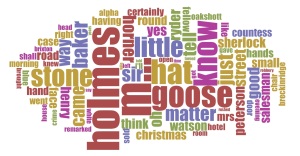Word Clouds are graphic visualizations of the most frequent words used in a text. This tool allows fresh interpretations to be made about any texts. It provides a unique way of looking at a cluster of frequently used words that may elicit a different understanding of what is being presented.
I chose to closely read The Adventures of Sherlock Holmes: The Blue Carbuncle and create a Word Cloud to develop a new understanding and a fresh perspective on the story. I used Voyant as a tool to generate a Word Cloud for the text.
Below is a Word Cloud for the entire story:
The Blue Carbuncle
After editing the stop words and removing irrelevant words, the most common words to appear in the text are: man, holmes, hat, goose, little, know, stone, bird, and geese (beginning with most frequent word). These words make sense considering the premise of the story involves an investigation of the missing blue carbuncle in the neck of a goose. However I feel that this visualization and understanding of what is most important and valuable in the text would benefit from excluding similar words such as “goose” and “geese” and “bird”. I will edit the stop words to take away “geese” and “bird” and a few other less frequently occurring words that seem to be duplicates in one way or another to see how it strengthens my observation. In the new Word Cloud, there is a stronger sampling of frequent and presumably important words. The most frequent words are: man, holmes, hat, goose, little, know, stone, just, sir, baker, and tell. These words are a little more precise and reveal a lot about the plot of the story.
A quick browse through the word trends shows some information about where words more frequently appear in the text. The most frequently occurring word “man” appears scattered throughout the text in an even fashion. This makes sense since it is such a generic word. The top three words used commonly at the beginning of the text are: hat, goose, and stone. The top three words used more towards the end of the text are: holmes, little, and know. If I had no prior knowledge of the story I would analyze this information as a story starting out confidently and ending up a mystery. There seems to be a clear understanding with these frequent words that the beginning of the story is set up in such a way that is confident and outlining the premise. There are strong nouns that identify the main points and symbols of the story. It highlights what is most important. As the story progresses there are mysterious things happening. A case is being investigated by Holmes. The frequently used words that appear more often towards the end of the story are Holmes (noun), little (adjective), and know (verb). Holmes is solving the mystery of the Blue Carbuncle so naturally one would expect his name to appear at the end or resolution of the story. Interpreting the words as “Holmes knowing little” is another angle that could be looked at. Even though he does solve the case, the majority of the story is all about clues and small bits of information that are used as a collective whole to solve a mystery. These words and their placement in the text may be valuable in understanding the key points and themes of the story.
Using the Word Cloud platform and Voyant tool to analyze a Sherlock Holmes story is a fun and interactive way to read and understand the text. Being able to control what words should or should not appear in the Word Cloud, viewing the word trends, and seeing the frequencies are all helpful and can be used to extract important symbols or themes in the text that may have otherwise gone unnoticed.
Erica Gedney
